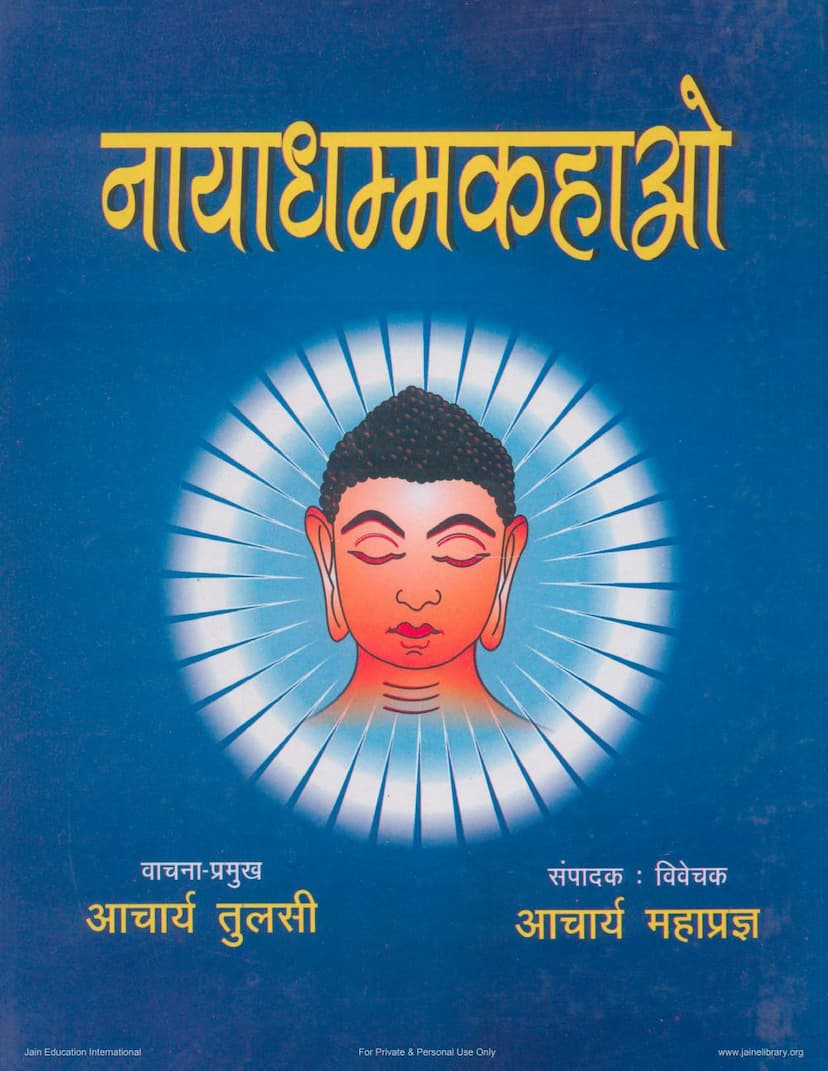Agam 06 Ang 06 Gnatadharma Sutra Nayadhammakahao Terapanth
Added to library: September 1, 2025

Summary
Here's a comprehensive summary of the Jain text "Agam 06 Ang 06 Gnatadharma Sutra Nayadhammakahao Terapanth," based on the provided pages:
Book Title: Agam 06 Ang 06 Gnatadharma Sutra Nayadhammakahao Author(s): Acharya Tulsi (Vachana-Pramukha), Acharya Mahapragna (Editor and Commentator) Publisher: Jain Vishva Bharati Catalog Link: https://jainqq.org/explore/003624/1
Overview:
This document is a publication by Jain Vishva Bharati of the Gnatadharma Sutra, also known as Nayadhammakahao, the sixth Anga of the Jain Agamas. It is presented in Prakrit with Hindi translation, commentary (Bhashya), and appendices. The publication is under the guidance of Acharya Tulsi and edited by Acharya Mahapragna.
Content and Structure:
The Gnatadharma Sutra is characterized by its narrative style, using stories and examples (Naya) to illustrate principles of Dharma (Nayadhammakahao). It falls under the Charanakarananuyoga category of Jain literature, focusing on ethical conduct and discipline through illustrative events.
The text is primarily in prose, with occasional poetic verses. The style varies, encompassing descriptive, narrative, and sometimes poetic prose. The structure of the Gnatadharma Sutra is divided into two Shrutaskandhas:
- Naya: This relates to the first Shrutaskandha and means "examples" or "illustrations."
- Dharmakatha: This relates to the second Shrutaskandha and means "narratives of Dharma" or "religious stories."
Significance of the Text:
- Narrative Approach: The text emphasizes the importance of stories and narratives in conveying philosophical and ethical concepts to the general populace, making them accessible and engaging.
- Cultural Heritage: It is recognized as a valuable repository of Jain philosophy, culture, and folk life.
- Gadyapradhan (Prose-dominant): The primary mode of expression is prose, though it includes poetic elements.
Key Aspects Discussed:
- Structure of the Agama: The introduction clarifies that the Naya relates to the first Shrutaskandha, and Dharmakatha to the second.
- Meaning of 'Naya': 'Naya' is explained as examples or illustrations, supported by references from other Jain texts and commentators who define it as 'drushtanta' (example) or 'aaharan' (illustration).
- Digambara Tradition: The text notes the name 'Nadharmakaha' or 'Gnatrudharmakatha' in the Digambara tradition, with interpretations linking 'Gnatr' to 'Gnatputra Mahavir,' suggesting it might refer to the dharma tales of Lord Mahavir from his lineage.
- Number of Studies (Adhyayanas):
- The first Shrutaskandha (Naya) contains nineteen studies. A list of these studies is provided, including 'Ukkhitnanae,' 'Sanghade,' 'Ande,' 'Kumme,' 'Selage,' 'Tumbe,' 'Rohini,' 'Malli,' 'Mayandi,' 'Chandima,' 'Davaddav,' 'Udaganaye,' 'Mandukke,' 'Teyali,' 'Nandiphale,' 'Avarakanka,' 'Aainne,' 'Susuma,' and 'Pundariye.'
- The second Shrutaskandha (Dharmakatha) is described as having ten categories of Dharmakathas, with an immense number of sub-narratives (an estimated 3.5 crore). However, these are currently unavailable.
- Reasons for the Loss of Dharmakatha: The text speculates that the loss of the vast Dharmakatha literature might be due to the greater focus of later Jain Acharyas on Dravyanuyoga and Charanakarananuyoga. Additionally, the limitations of writing and memory retention for such a massive volume of stories could have contributed to their disappearance. The need to preserve the core twelve Angas might have led to prioritization, potentially at the expense of Dharmakatha.
- Content of the Studies: The introduction and the detailed table of contents (Vishayanukram) reveal the profound philosophical and ethical content within each study. Many studies use allegorical narratives featuring animals, royalty, or common people to convey Jain teachings on topics like:
- Vairagya (Detachment): Recalling past lives (Jatismriti) as a catalyst for detachment.
- Gupti (Control): The importance of controlling the mind, speech, and body, exemplified by the tortoise.
- Apramada (Vigilance): Demonstrating the states of vigilance and negligence.
- Asakti (Attachment): The subtle line between nourishing the body and attachment to it.
- Shraddha (Faith): The power of faith in spiritual journeys, contrasted with doubt.
- Indriya Vijaya (Control of Senses): Illustrating the consequences of uncontrolled senses.
- Patience and Tolerance: Discussing options for devotion and transgression based on tolerance.
- Pudgala Parinamavada (Theory of Substance Transformation): Establishing the principle of change in matter.
- Durgati and Sugati: Showing contrasting states of existence for the same being.
- Vairagya as a Cause of Renunciation: Demonstrating how insults can lead to renunciation.
- Self-Control: Illustrating how self-control helps avoid undesirable consequences.
- Ahimsa: Highlighting the practice of non-violence.
- Aparigraha (Non-possession): The importance of non-attachment in the final stages of life.
- Dharmakatha principles: The text also outlines four types of kathas (narratives) as per the Sthananga Sutra: Akṣepaṇī (expository), Vikṣepaṇī (divergent), Sanvejani (instructive), and Nirvedani (discouraging).
- Stylistic Features: The text notes the prose-heavy nature, with variations in style (descriptive, poetic), sentence structure (complex vs. simple), and the inclusion of verses.
- Stylistic Observations: Certain words or phrases, like 'nirgrantha pravachana' and 'chaturyama grihadharma,' are noted as potentially stylistic or belonging to a particular period (e.g., related to Lord Aristhanemi's time), requiring historical consideration for accurate interpretation.
- Textual Analysis: The publication includes detailed textual analysis, including the critical discussion of certain words, providing variant readings and interpretations for scholarly understanding.
- Contribution of Acharyas: The publication is a testament to the dedicated work of Acharya Tulsi and Acharya Mahapragna, along with their team of Sadhvis and Munis, in preserving and presenting this significant Jain scripture. The 'Samarpan' and 'Antahstosha' sections highlight their deep satisfaction and gratitude for the successful completion of this scholarly endeavor.
Overall Summary:
The Gnatadharma Sutra (Nayadhammakahao) is a crucial text within the Jain Agamas, specifically the sixth Anga. It employs a rich tapestry of stories and examples to elucidate Dharma, emphasizing ethical conduct and spiritual discipline. The text is primarily prose-based, showcasing various stylistic elements. Its two Shrutaskandhas, Naya and Dharmakatha, highlight its didactic purpose. Despite the current unavailability of the vast majority of its original Dharmakatha content, the surviving Naya studies provide invaluable insights into Jain philosophy, ethics, psychology, and cultural life, illustrating concepts like detachment, control, faith, and the consequences of attachment and aversion through relatable narratives. The publication by Jain Vishva Bharati represents a significant scholarly effort to make this ancient scripture accessible with comprehensive translations and commentaries.